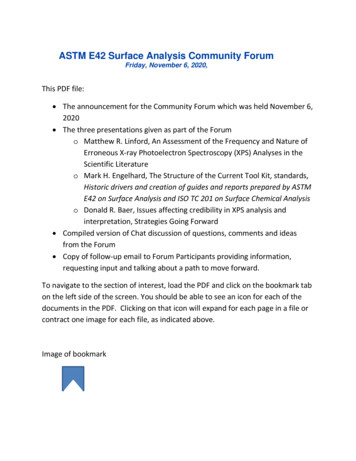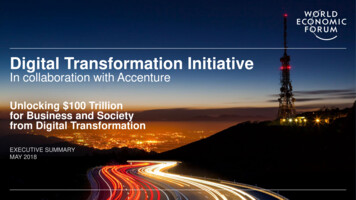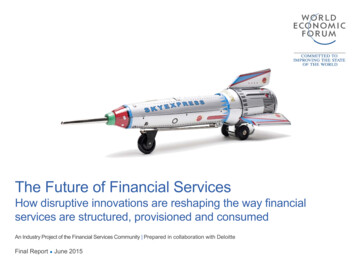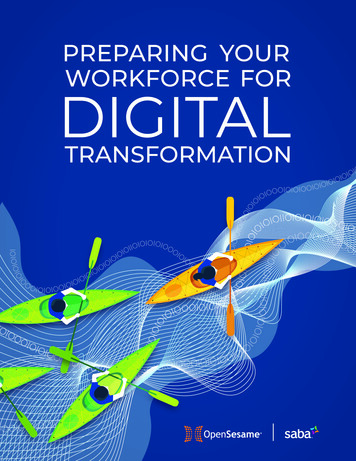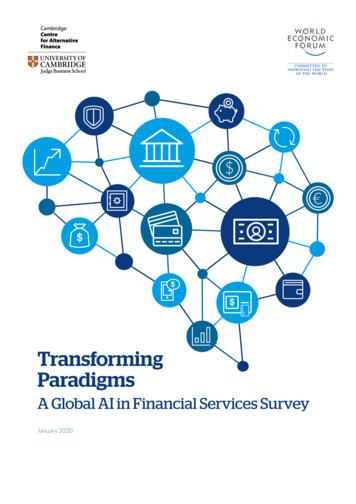
Transcription
TransformingParadigmsA Global AI in Financial Services SurveyJanuary 2020
Transforming ParadigmsA Global AI in Financial Services Survey
Table of ContentsForewords. 6Research Team. 9Executive Summary .11Chapter 1: Introduction .161.1 A Brief Juxtaposition of AI and Machine Learning.161.2 Literature Review.171.2. Survey Methodology and Sample Statistics.21Chapter 2: The Adoption of AI in Financial Services.262.1 State and Development of AI Adoption. 262.2 Specific Application Areas of AI. 302.3 AI-Empowered Product- and Process Innovation Approaches. 332.4 Investment in AI. 35Chapter 3: The Business Impact of AI. 403.1. The Future Business Relevance of AI. 403.2 How AI Affects Existing Business Attributes. 433.3 Propelling Novel Business Value Through AI-Enabled B2B Offerings. 44Chapter 4: Hurdles to AI Implementation.504.1 Overall Implementation Hurdles. 504.2 Hurdles for AI Leaders and Laggards.524.3 Hurdles Across Financial Services Sectors. 534.4 Management Teams’ Understanding of AI. 54Chapter 5: Market-Wide Implications of AI Implementation.585.1 The Impact on Jobs. 585.2 The Potential for Competitive Disruption.595.3 The Impact of ‘Big Tech’. 60Chapter 6: AI as a Risk Driver in Financial Services.646.1 The Risk Landscape in an AI-Enabled Industry. 646.2 Reconciling the Market- and Firm-Level Risk Outlook. 666.3 Mapping AI-Related Risks by Sector and Jurisdiction. 686.4 Risk Mitigation and the Role of AI. 70
Chapter 7: Regulation of AI in Financial Services. 767.1 AI – A Nascent, Global Regulatory Agenda.767.2 Beyond the Regulatory Burden. 777.3 Supportive Regulation as Comparative Advantage or Under-Regulation asUnfair Advantage?. 807.4 Are Regulations Enabling or Impeding AI Adoption?.817.5 Relationship with Law Enforcement. 83Chapter 8: The Use of Data for AI in Financial Services .888.1. The Importance of Data. 888.2. Data Sources. 888.3. Usage of Customer Data. 898.4. Usage of Alternative Data. 90Chapter 9: Deep Dive – AI-Enabled Credit Analytics.949.1. Expected Benefits of AI-Enabled Credit Analytics. 949.2. Will the Usage of AI in Credit Analytics Exacerbate Bias?. 95Chapter 10: Deep Dive – Investment Management . 10010.1 Using AI in the Investment Process. 10010.2 Future Outlook.102Chapter 11: The State of AI-Enabling Technology.10611.1 Autonomous AI – the Future of Financial Services?. 10611.2 Implementation of Underlying Machine Learning Paradigms. 10811.3 The Use of Computational Resources.110Chapter 12: Learnings and Outlook. 11412.1 Generalising Findings Across the Financial Services Industry.11412.2 Developing AI Capabilities – a Must for Financial Service Providers? .11512.3 The Future of AI-Enabling Technology.11512.4 Future Power Dynamics in Financial Services.116References.120
ForewordsForewordsIn 1950, five years before the term ‘Artificial Intelligence’ (AI) was coined by John McCarthy, AlanTuring already posed the question “Can machines think?” and devised the Turing Test. 70 years on,the world’s computational capability has grown by leaps and bounds, and so has the application of AIacross a wide array of industries, including Financial Services. However, beyond the news headlinesand opinion pieces, there is still very limited empirical evidence available on the current state of AIadoption in finance and its implications. This global survey, jointly conducted by the Cambridge Centrefor Alternative Finance (CCAF), at the University of Cambridge Judge Business School and the WorldEconomic Forum, is aimed at going beyond the hype and hyperbole, to provide some empirical dataand shed light on the evolving landscape of AI-enabled Financial Services.Based on a survey sample of 151 firms which included both FinTechs and Incumbents, this study wasable to depict a global Financial Services sector that is undergoing profound digital transformationunderpinned by the advancement in AI. The research findings point to increasing adoption of AI infinance, as firms are leveraging AI to revamp existing offerings and create new products and services.AI is helping firms transform practices, processes, infrastructure and underlying business models, forexample selling AI as a service. This research unveils how Financial Services firms are facing hurdlesto AI implementation, including access to data, access to talent, and regulatory uncertainties. Thisstudy also examined potential and realised risks with growing adoption of AI in finance, the impact onworkforces in both the short and long term across industry verticals, and strategic learnings from thecurrent frontrunners of AI implementation.Nevertheless, it is evident that more research needs to be done in order to better understand theopportunities and challenges brought about by the eventual mass adoption of AI in Financial Services.For instance, how can finance firms open up the ‘black box’ of AI and facilitate more explainable andtransparent applications? As AI is becoming increasingly autonomous, what will the roles of humansbe and how would an effective human-in-the-loop AI system manifest itself? What are some socioeconomic repercussions and ethical implications of AI-induced biases and risks? How can regulatorsand policymakers harness technology solutions to effectively regulate and supervise AI in finance?This report, therefore, marks just the beginning of a long journey for us to collectively comprehend thepotential, possibilities, and boundaries of AI in finance. We are profoundly grateful to EY and Invescofor enabling us to produce this empirical study and for their helpful feedback during the researchprocess. We are also very thankful to the financial service providers who took part in our globalsurvey. Finally, we would like to thank the interdisciplinary CCAF-Forum research team led by LukasRyll, which over the last many months worked tirelessly and collaboratively to create this study.Matthew BlakeHead of Financial & Monetary SystemsWorld Economic ForumBryan ZhangExecutive DirectorCambridge Centre for Alternative Finance6
Transforming Paradigms – A Global AI in Financial Services SurveyI am delighted that EY have once again had the opportunity to work with the Cambridge Centre forAlternative Finance at the Judge Business School, University of Cambridge on the publication of aground breaking study. Not only does this report provide a comprehensive view of the adoption ofAI in Financial Services, it highlights the challenges, opportunities and future considerations that theindustry faces.Over recent years, artificial intelligence (AI) has been an area of focus across a range of industries,triggered by the need for increased speed and efficiency, automation of manual processes, andintelligent computer-based decision-making. Institutions are investing significant time and money inimplementing the technology and understanding how its potential can be unlocked to deliver benefitsacross industries.At EY, we are focused on the challenging business problems for which AI may present a compellingnew solution, and in doing so, enable the business models of the future. The key characteristics of thetechnology, built from the principles of intelligent automation, machine learning (ML), and automateddecision-making, rely upon AI’s ability to predict, adapt, learn and empower business decisions.However, to really see AI’s full potential in a tightly regulated Financial Services industry, there is stillwork to be done to build trust and confidence in areas such as explainability, security and compliance,integration alongside the human workforce, and ultimately, identification of the richest opportunitiesto deliver business value.This global study provides an important reference for leaders in all sectors to better understandcurrent areas of focus, attitudes toward AI and future considerations that need to be addressed. Welook forward to working with our clients, both traditional Financial Services businesses and FinTechs,to deploy AI technology to transform their businesses.We would like to thank the Cambridge Centre for Alternative Finance, the World Economic Forum,Invesco, and the survey participants for making this comprehensive and ground-breaking studypossible.Nigel DuffyPartner, Global Artificial Intelligence LeaderEY7
ForewordsThe global asset management industry is in the midst of unprecedented change. A recent report fromthe U.S. Securities and Exchange Commission’s Asset Management Advisory Committee says that,“Drastic changes in the capital markets in which shops operate, as well as new demands that youngergenerations will expect of the advice market, are creating the ‘strongest shifts’ asset managers haveseen in more than 40 years.” Facing such strong external forces, asset managers are looking for waysto embed emerging technologies like artificial intelligence into their operational strategies in order tocreate competitive advantage. This study highlights how AI is affecting the global Financial Servicesindustry, with 72% of decision makers stating that they believe AI is the business advantage of thefuture.The report begins with addressing the nuanced differences between artificial intelligence andmachine learning, making the important distinction that the two, while interdependent, are notinterchangeable.“Transforming Paradigms” digs into the five thematic areas where AI will have the most impact andhighlights the amazing opportunity ahead of us in Financial Services for using artificial intelligenceand machine learning to the benefits of our customers and our organisations. Technological advancessuch as leveraging intelligence to define investments for customers tied to their personalised goals,improving customer experience through the use of intelligent bots, additional alpha generation viainsights from alternative datasets, and operational efficiencies through machine learning automation,will soon become the norm for our industry.Among the most notable insights are the idea that combined efforts of adopting AI/ML across theFinancial Services industry are raising the bar for client expectations, that there is a widening gapbetween leaders and laggards in adopting and implementing AI and the changing dynamics betweenfintechs and incumbents, who are no longer seen as mutual threats, but potential allies with the rightstrategic fit. Lastly, the study introduces the idea of the “AI Flywheel”, the tendency for AI models toexhibit self-reinforcing economies of scale.As with other emerging technologies, AI faces similar challenges with nascent regulatory frameworksand issues with identifying and recruiting qualified talent.Real value from AI/ML projects comes from having clear business use cases, and it is unsurprisingthat 61% of investment managers look to AI to generate new revenue potential. The findings validateour own experiences, as we deploy AI/ML tools to help our investors make better decisions and makeour distribution professionals more efficient. Invesco is especially committed to using “augmentedintelligence” to supports, rather than replaces, humans and to upskilling our employees to self-servewith AI/ML tools.We’d like to thank everybody who contributed to the collection and synthesis of data for thisreport, as findings such as these provide valuable insights to help inform a wider audience about theimplementation of emerging technologies around the world.Donie LochanChief Technology OfficerInvescoDave DowsettHead of Technology Strategy, Innovation and PlanningInvesco8
Transforming Paradigms – A Global AI in Financial Services SurveyResearch TeamLead ResearchersLukas Ryll (CCAF), Mary Emma Barton (World Economic Forum),Bryan Zheng Zhang (CCAF) and Jesse McWaters (World Economic Forum and Independent)Researchers and Co-AuthorsEmmanuel Schizas (CCAF), Rui Hao (CCAF), Keith Bear (CCAF), Massimo Preziuso (Cork UniversityBusiness School), Elizabeth Seger (University of Cambridge), Robert Wardrop (CCAF),Raghavendra Rau (CCAF), Pradeep Debata (University of Cambridge), Philip Rowan (CCAF),Nicola Adams (CCAF), Mia Gray (CCAF) and Nikos Yerolemou (CCAF)Other contributors:Lin Lin (National University of Singapore), Christian Hugo Hoffmann (ETH Zurich) and MatthewSaunders (Independent)AcknowledgementsWe would like to thank EY and Invesco for their generous financial support without which this studywould not have been possible. Moreover, we would like to extend our utmost gratitude to Nigel Duffy,Christopher Schmitz, Thomas Bull, Tom Hill, LeeAnn Manon, Kailyn Smigelski and Charlotte Johnsonfrom EY as well as Donie Lochan, Kevin Lyman, Henning Stein, Dave Dowsett, Mindy Guthrie, BradleyBell and Tatiana Nemo from Invesco for their invaluable input and continuous support during theresearch and publication processes.We gratefully acknowledge Charles Goldsmith and Philippa Coney from the Cambridge JudgeBusiness School and Madeleine Hillyer from the World Economic Forum for their contribution to thedissemination of the report.We would also like to thank Ariane Chapelle, Tania Ziegler, Apolline Blandin, Kieran Garvey and ZhangWei for their valuable support in disseminating the survey. We would furthermore like to extend ourgratitude to Ishani Majumdar and Jayesh Masand for their ideas and input as well as Sarah Carter,James Morgan, Kate Belger and Yvoina Duncan for their support.Finally, we thank Louise Smith for her meticulous work on designing the report.9
Research Team and AcknowledgementsThe research team is grateful for the support of these organisations and associations for theirgenerous support in distributing the survey across the globe:We would like to thank all the financial companies and institutions that took part in the survey (Pleasenote that many participants preferred to keep their participation confidential and are thus not listed here):10
Transforming Paradigms – A Global AI in Financial Services SurveyExecutive SummaryThis report presents the findings of a global survey on AI in Financial Services jointly conducted bythe Cambridge Centre for Alternative Finance (CCAF) at the University of Cambridge Judge BusinessSchool and the World Economic Forum in Q2-Q3 2019. Representing one of the largest globalempirical studies on AI in Financial Services, a total of 151 respondents from 33 countries participatedin the survey, including both FinTechs (54% of the sample) and incumbent financial institutions (46% ofthe sample). The study was supported by EY and Invesco.The study’s objective was to analyse and understand the current state of AI adoption in FinancialServices, as well as its subsequent implications. This was done through the comparative analysis ofempirical data collected via a web-based questionnaire.This research provides a comprehensive picture of how AI is currently being applied in FinancialServices by both FinTechs and Incumbents; driving different business models; underpinning newproducts and services; and playing a strategic role in digital transformation. The findings also revealhow financial service providers across the globe are meeting the challenges of AI adoption with itsemerging risks and regulatory implications, as well as the impact of AI on the competitive landscapeand employment levels.The overarching findings of the study suggest that AI is expected to transform a number of differentparadigms within the Financial Services industry. These anticipated changes include how data isutilised to generate more actionable insights; business model innovation (e.g., selling AI as a service);changes to the competitive environment with the entrance of ‘Big Tech’ and consolidation; variousimpacts on jobs and regulation; impacts on risks and biases; and the further development andadoption of game-changing technologies.The pace of AI application in Financial Services is clearly accelerating as companies begin to leverageAI to increase profitability and achieve scale. This has complicated and multifaceted implications andrepercussions.The key findings of this empirical study are as follows: AI is expected to turn into an essential business driver across the Financial Services industryin the short run, with 77% of all respondents anticipating AI to possess high or very high overallimportance to their businesses within two years. While AI is currently perceived to have reached ahigher strategic relevance to FinTechs, Incumbents are aspiring to catch up within two years. The rising importance of AI is accompanied by the increasingly broad adoption of AI acrosskey business functions. Approximately 64% of surveyed respondents anticipate employing AIin all of the following categories – generating new revenue potential through new products andprocesses, process automation, risk management, customer service and client acquisition – withinthe next two years. Only 16% of respondents currently employ AI in all of these areas. Risk management is the usage domain with the highest current AI implementation rates(56%), followed by the generation of new revenue potential through new AI-enabled productsand processes, adopted by 52%. However, firms expect the latter to become the most importantusage area within two years.11
Executive Summary AI is expected to become a key lever of success for specific Financial Services sectors. Forexample, it is expected to turn into a major driver of investment returns for asset managers.Lenders widely expect to profit from leveraging AI in AI-enabled credit analytics, while paymentproviders anticipate expanding their AI usage profile towards harnessing AI for customer serviceand risk management. With the race to AI leadership, the technological gap between high and low spenders iswidening as high spenders plan to further increase their R&D investments. These spendingambitions appear to be driven by more-than-linear increases in pay-offs from investing in AI, whichare shown to come into effect once AI investment has reached a ‘critical’ mass of approximately10% R&D expenditure. FinTechs appear to be using AI differently compared to Incumbents. A higher share of FinTechstends to create AI-based products and services, employ autonomous decision-making systems,and rely on cloud-based offerings. Incumbents predominantly focus on harnessing AI to improveexisting products. This might explain why AI appears to have a higher positive impact on FinTechs’profitability, with 30% indicating a significant AI-induced increase in profitability compared to 7%of Incumbents. FinTechs are more widely selling AI-enabled products as a service. Successful real-worldimplementations demonstrate that selling AI as a service may allow large organisations to create'AI flywheels' - self-enforcing virtuous circles - through offering improved AI-driven services basedon larger and more diverse datasets and attracting talent. AI Leaders generally build dedicated corporate resources for AI implementation and oversight– mainly a Data Analytics function – to work with their existing IT department. On average,they also use more sophisticated technology to empower more complex AI use cases. Leveraging alternative datasets to generate novel insights is a key part of harnessingthe benefits of AI with 60% of all respondents utilising new or alternative forms of data in AIapplications. The most frequently used alternative data sources include social media, data frompayment providers, and geo-location data. Incumbents expect AI to replace nearly 9% of all jobs in their organisation by 2030, whileFinTechs anticipate AI to expand their workforce by 19%. Within the surveyed sample, thisimplies an estimated net reduction of approximately 336,000 jobs in Incumbents and an increaseof 37,700 jobs in FinTechs. Reductions are expected to be highest in Investment Management, withparticipants anticipating a net decrease of 10% within 5 years and 24% within 10 years. Regardless of sectors and entity types, quality of and access to data and access to talent areconsidered to be major obstacles to implementing AI. Each of these factors is perceived to be ahurdle by more than 80% of all respondents, whereas aspects like the cost of hardware/software,market uncertainty, and technological maturity appear to represent lesser hindrances. Almost 40% of all respondents feel that regulation hinders their implementation of AI,whereas just over 30% perceive that regulation facilitates or enables it. Organisations feelmost impeded by data sharing regulations between jurisdictions and entities, but many also deemregulatory complexity and uncertainty to be burdensome. Firms’ assessments of the impact ofregulation tend to be more positive in China than in the US, the UK, or mainland Europe.12
Transforming Paradigms – A Global AI in Financial Services Survey Mass AI adoption is expected to exacerbate certain market-wide risks and biases, and at leastone in five firms do not believe they are well placed to mitigate those. Firms are particularlywary of the potential for AI to entrench biases in decision-making, or to expose them, throughshared resources, to mass data and privacy breaches. Nevertheless, many firms are involving Riskand Compliance teams in AI implementation, and those who do tend to be more confident in theirrisk mitigation capability as a result. Long-established, simple machine learning algorithms are more widely used than complexsolutions. Nonetheless, a large share of respondents is planning to implement Natural LanguageProcessing (NLP) and Computer Vision, which commonly involve Deep Learning, within two years. Nearly half of all participants regard ‘Big Tech’1 leveraging AI capabilities to enter FinancialServices as a major competitive threat.1Defined as major technology companies, such as Google, Facebook or Tencent13
Executive Summary14
Regulating Alternative Finance – Results from a Global Regulator Survey1. I ntroduction15
Chapter 1: IntroductionChapter 1: Introduction1.1 A Brief Juxtaposition of AI and Machine LearningArtificial Intelligence Pattern detection by recognising (ir)regularities in dataArtificial Intelligence (AI) is a term shapedby socio-behavioural rationales of humancapabilities – essentially, expectations thatmachines could emulate human cognition andbehaviour. Expectations of AI are derived andoften benchmarked against human intelligence.The corollary is understanding that AI may beapproached by attempting to understand humanintelligence itself. While various definitions ofintelligence have been proposed, Gottfredsonnotes in his editorial Mainstream science onintelligence that intelligence may be defined as: Foresight by extrapolating learned patterns inthe presence of uncertainty Customisation by generating rules fromspecific profiles and applying general data tooptimise outcomes Decision-making by generating rules fromgeneral data and apply specific profiles againstthose rules Interaction by communicating with humansthrough digital or analogue mediums“A very general mental capability that, among otherthings, involves the ability to reason, plan, solveproblems, think abstractly, comprehend complexideas, learn quickly and learn from experience. It isnot merely book learning, a narrow academic skill,or test-taking smarts. Rather, it reflects a broaderand deeper capability for comprehending oursurroundings—‘catching on’, ‘making sense’ of things,or ‘figuring out’ what to do” (Gottfredson, 1997)Machine LearningWhile underlying concepts of AI and machinelearning suggest significant overlaps, the term‘machine learning’ is more distinctly derived fromexisting frameworks in neuroscience, computerscience, statistics, and mathematics. Accordingto a definition which was originally coined byMendel and McLaren (1970) and refined byHaykin (1994), machine learning describes thechange of a system resulting from an interactionwith its environment, as shown in Figure 1.1below. A system interacts with its environmentin such a way that the structure of the systemchanges, in turn transforming its interaction withits environment, creating an iterative process.Extrapolating these traits to a set of distinctmachine capabilities, this report follows thedefinition adopted by previous World EconomicForum reports2 in characterising AI as a suiteof technologies, exhibiting some degree ofautonomous learning and enabling:2The New Physics of Financial Services (McWaters et al., 2018)16
Regulating Alternative Finance – Results from a Global Regulator SurveyFigure 1.1: A high-level diagram of machine learningInteractionEnvironmentSystemIterative LearningNew SystemIn computer science, machine learning is partof a broader field called ‘Soft Computing’. Thisencompasses systems that find approximate (or‘soft’) solutions to problems which do not possessexact (or ‘hard’) solutions.their businesses may be explained by the term‘machine learning’. Salient characteristics ofhuman intelligence such as meta-learning4 ,self-reflection and human interaction,which essentially fill the gap between theterms ‘machine learning’ and ‘AI’ are stillunderdeveloped. Nonetheless, the suiteof technologies investigated in this studyis subsumed under the umbrella term ‘AI’and named as such to ensure completeness.References to machine learning are made wherethe findings are specific enough to distinguishthese denotations.As such, machine learning algorithms canbe clearly distinguished from traditionalcomputer programs which follow a static setof predetermined instructions. A rule-basedcomputer algorithm will always arrive at the samesolution given a set of inputs, whereas traininga machine learning algorithm multiple times willlargely yield different solutions.1.2 Literature ReviewIn summary, comparing AI and machine learningreveals that the term ‘Artificial Intelligence’focuses on the meaning and impact of thesystem’s interaction with its environmentwhereas ‘machine learning’ focuses on the natureof the system involved in the interaction, as wellas the nature of the interaction itself. Machinelearning may thus be seen as a technical term forwhat is essentially an enabling subset of the AIparadigm. This also means that the terms cannotbe used interchangeably.According to the OECD (2019) “AI has pervasive,far-reaching and global implications that aretransforming societies, economic sectors andthe world of work, and are likely to increasinglydo so in the future.” With the potential of AIin mind, many public and private institutionshave investigated the application of AI onFina
Jan 17, 2020 · machine learning, making the important distinction that the two, while interdependent, are not interchangeable. “Transforming Paradigms” digs into the five thematic areas where AI will have the most impact and highlights the amazing opportunity ahead of u



